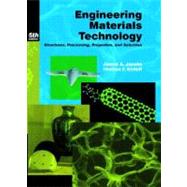
| Nature & Structure | |
| Engineering Materials Technology | |
| Nature and Family of Materials | |
| Synthesis, Processing & Structure of Solid Materials | |
| Properties Of Materials | |
| Properties-Defined & Mechanical | |
| Chemical, Thermal, & Tribological Properties and Corrosion | |
| Electrical & Optical Properties | |
| Evaluation, Standards, Design & Selection | |
| Testing, Failure Analysis, Inspection & Standards | |
| Materials Design, Selection & Characterization | |
| Metallics | |
| Nature and Thermal Processing of Metals | |
| Ferrous Metals | |
| Nonferrous Metals | |
| Metals Powders & Powder Metallurgy | |
| Surface Science & Engineering | |
| VI | |
| Nature of Polymers | |
| Plastics | |
| Elastomers: Natural & Synthetic Rubbers | |
| Adhesives & Other Important Polymerics | |
| Wood & Related Products | |
| Ceramic Materials | |
| Nature & Design of Ceramics | |
| Ceramic Processing | |
| Refractives, Cement, Concrete, Clay, Protective Coatings, & Abrasives | |
| Electronic, Magnetic Ceramics, Smart Ceramics | |
| Glass, Radioactive Materials & Nuclear Fuels | |
| Composite Materials | |
| Fiber Structures & Properties | |
| Composite Structures, Types & Processing | |
| Fastening, Machining, Repair & Evaluation | |
| OTher Important Materials And Materials Systems Technology | |
| Microelectronics Semiconductor Material Electron Band Theory | |
| Smart Materials, Biometics, Biomaterials Molecular & Nano Systems Engineering, & Manufacturing | |
| Appendices | |
| Index | |
| Table of Contents provided by Publisher. All Rights Reserved. |
The New copy of this book will include any supplemental materials advertised. Please check the title of the book to determine if it should include any access cards, study guides, lab manuals, CDs, etc.
The Used, Rental and eBook copies of this book are not guaranteed to include any supplemental materials. Typically, only the book itself is included. This is true even if the title states it includes any access cards, study guides, lab manuals, CDs, etc.